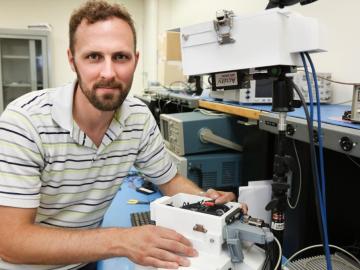
Filter News
Area of Research
- (-) Energy Science (29)
- (-) Supercomputing (32)
- Biology and Environment (11)
- Computer Science (1)
- Fusion and Fission (2)
- Isotopes (1)
- Materials (38)
- Materials for Computing (2)
- National Security (5)
- Neutron Science (21)
- Nuclear Science and Technology (9)
- Quantum information Science (2)
- Sensors and Controls (1)
News Type
News Topics
- (-) Advanced Reactors (2)
- (-) Bioenergy (10)
- (-) Biomedical (7)
- (-) Computer Science (32)
- (-) Coronavirus (12)
- (-) Materials Science (11)
- (-) Microscopy (3)
- (-) Security (2)
- 3-D Printing/Advanced Manufacturing (18)
- Artificial Intelligence (7)
- Big Data (6)
- Biology (2)
- Biotechnology (1)
- Chemical Sciences (2)
- Clean Water (1)
- Composites (1)
- Cybersecurity (3)
- Energy Storage (11)
- Environment (12)
- Exascale Computing (3)
- Grid (6)
- High-Performance Computing (2)
- Isotopes (1)
- Machine Learning (4)
- Materials (2)
- Mathematics (2)
- Molten Salt (1)
- Nanotechnology (5)
- National Security (1)
- Neutron Science (9)
- Nuclear Energy (3)
- Physics (3)
- Polymers (3)
- Quantum Science (9)
- Space Exploration (1)
- Summit (13)
- Transportation (11)
Media Contacts

An international team of researchers has discovered the hydrogen atoms in a metal hydride material are much more tightly spaced than had been predicted for decades — a feature that could possibly facilitate superconductivity at or near room temperature and pressure.

The formation of lithium dendrites is still a mystery, but materials engineers study the conditions that enable dendrites and how to stop them.

A team from the ORNL has conducted a series of experiments to gain a better understanding of quantum mechanics and pursue advances in quantum networking and quantum computing, which could lead to practical applications in cybersecurity and other areas.

Scientists at have experimentally demonstrated a novel cryogenic, or low temperature, memory cell circuit design based on coupled arrays of Josephson junctions, a technology that may be faster and more energy efficient than existing memory devices.

Researchers at ORNL have developed a quantum chemistry simulation benchmark to evaluate the performance of quantum devices and guide the development of applications for future quantum computers.

Researchers across the scientific spectrum crave data, as it is essential to understanding the natural world and, by extension, accelerating scientific progress.
Scientists studying a valuable, but vulnerable, species of poplar have identified the genetic mechanism responsible for the species’ inability to resist a pervasive and deadly disease. Their finding, published in the Proceedings of the National Academy of Sciences, could lead to more successful hybrid poplar varieties for increased biofuels and forestry production and protect native trees against infection.

Long-haul tractor trailers, often referred to as “18-wheelers,” transport everything from household goods to supermarket foodstuffs across the United States every year. According to the Bureau of Transportation Statistics, these trucks moved more than 10 billion tons of goods—70.6 ...

As leader of the RF, Communications, and Cyber-Physical Security Group at Oak Ridge National Laboratory, Kerekes heads an accelerated lab-directed research program to build virtual models of critical infrastructure systems like the power grid that can be used to develop ways to detect and repel cyber-intrusion and to make the network resilient when disruption occurs.

Brixon, Inc., has exclusively licensed a multiparameter sensor technology from the Department of Energy’s Oak Ridge National Laboratory. The integrated platform uses various sensors that measure physical and environmental parameters and respond to standard security applications.


